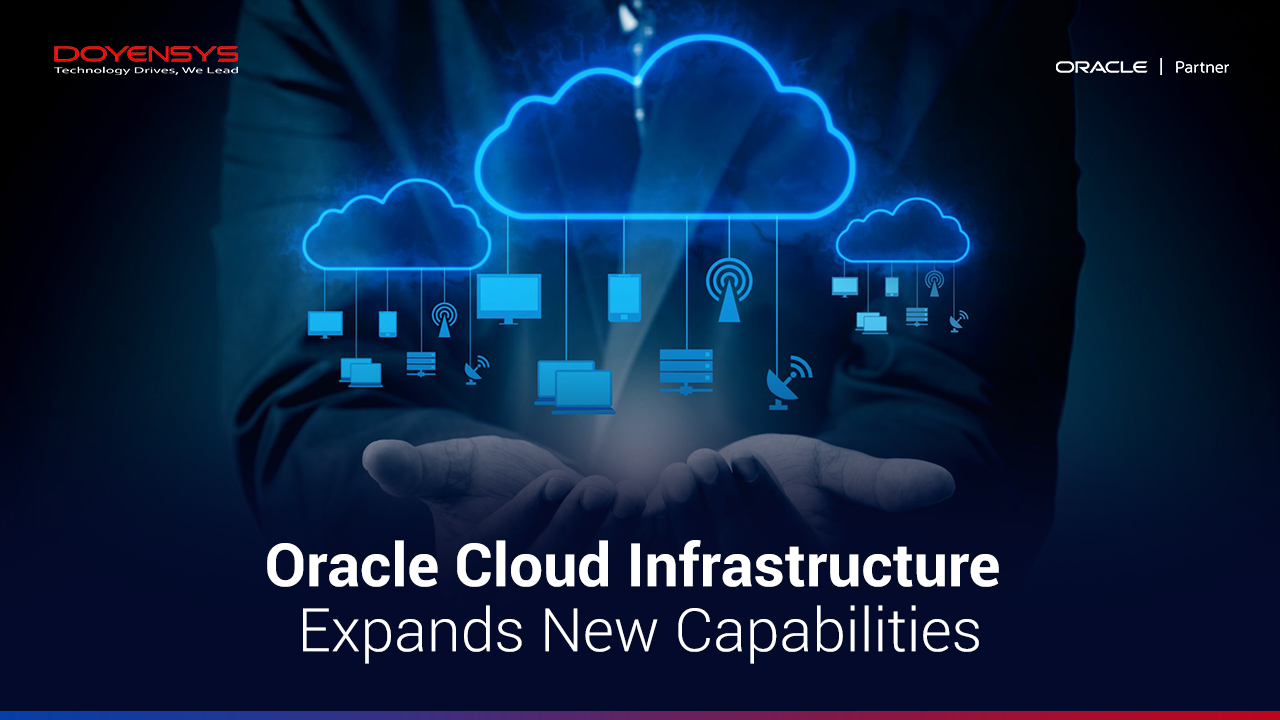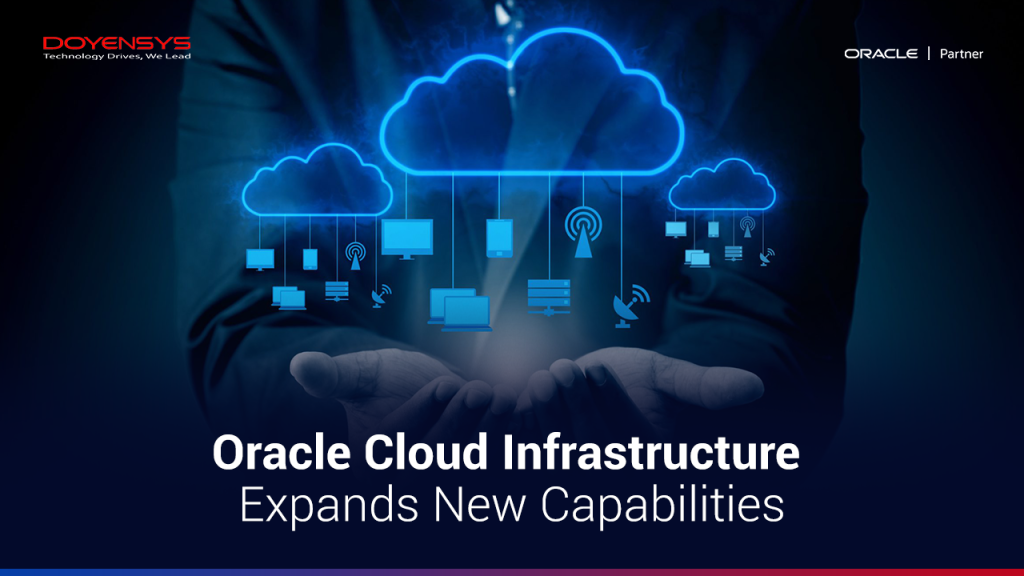
The base of your cloud estate is your core cloud infrastructure. Like the motor in your car, its goal is to work quietly and consistently. Your fundamental cloud infrastructure can – and should – continue to evolve and improve, much as our car engines have changed from gasoline-powered to hybrid and electric motors that do the same thing but more effectively.
Industry analysts have determined that OCI offers the essential IaaS and PaaS features for cloud applications. And to further the innovation in the industry, OCI has announced new computing, storage, and networking capabilities that can streamline the utilization of fundamental cloud infrastructure.
Let’s see what’s new.
 Bringing a flexible infrastructure:
Bringing a flexible infrastructure:
Providers of cloud services package resources like typical compute instances with 2 CPUs and 8 GB of RAM. Customers are put under pressure by this setting to size these resource bundles for workloads properly. Furthermore, from a financial viewpoint, cloud infrastructure may be expensive and ineffective if you only use half of a package’s resources.
More than 3 million cloud computing SKUs are currently available on the market, according to 451 Research. While some vendors might provide more than 500 compute SKUs, OCI has chosen a more simplified strategy.
Compute instance pools, burstable instances, preemptible instances, flexible computing, and load balancers are just a few features that OCI already offers. The capabilities of this collection of products are comparable to those of other suppliers, but they offer more customization choices than most.
With the ability to automatically adjust resources based on workload demands, OCI has advanced the scenario while lowering waste and expense. Here are a few of the new additions.
- Unlimited mode for burstable VMs: A feature that will foster continuous burst is necessary for running enterprise workloads cost-effectively. You can endlessly burst while only paying for a portion of the CPU that you view with the help of unlimited mode.
- Block Volume autotuning: Block storage that dynamically scales performance within limits you define to meet workload demands.
Because you’re only using what your workload requires, these capabilities contribute to increased efficiency and cost savings.
Simplified services
A recent poll by the Cloud Native Computing Foundation (CNCF) revealed that one of the biggest problems is the complexity of Kubernetes operations. With 90 percent of enterprises utilizing cloud-managed services, Kubernetes is also operating “under the hood” like Linux.
OCI already provides a managed Kubernetes service, but with new additions, they wanted to make it even easier to operate container-based applications in the cloud by providing a full serverless experience. By allowing users to run applications without having to manage any servers, serverless solutions can help simplify and lower the cost of monitoring, scaling, updating, and troubleshooting infrastructure.
Here are the new capabilities to make Kubernetes and containers simpler:
- Oracle Container Engine for Kubernetes: With this, customers can build Kubernetes clusters with Virtual Nodes to experience serverless computing fully. Enterprises can increase reliable operations at scale without having to worry about operational burdens thanks to Virtual Nodes, which manage the whole lifespan and infrastructure operations of the Kubernetes worker nodes.
- OCI Container Instances: A brand-new serverless computing service that is appropriate for users who want to run containers in the cloud for use cases that don’t call for Kubernetes-style container orchestration. Customers won’t need to manage infrastructure to rapidly launch containers with a single CLI command or a guided GUI wizard.
Customers are only charged at the same cost as normal OCI Compute for the CPU and memory resources assigned to their instances. Container Instances are designed to provide the best value for operating containers in the cloud, with an easy user interface, smooth operations, and no additional cost for the serverless experience.
- Cloud Advisor: Through services like Cloud Advisor, which identifies wasted resources and performance bottlenecks, OCI will simplify other facets of the fundamental cloud infrastructure. With tools for topology visualization, troubleshooting, diagnostics, network services planning, and traffic monitoring, it offers visibility across networks.
- Network Command Center: It offers total transparency into the security policy, performance, and topology of the network. Network Command Center is a tool that customers can use for network configuration problems, planning workload placements based on performance and security requirements, and traffic monitoring for compliance and security analysis. The desired network operator tools are provided by Network Command Center in a single & user-friendly interface.
Built-in security:
For customers to effortlessly secure their cloud infrastructure, data, and apps, OCI offers easy, prescriptive, and integrated security features built into the OCI platform. Furthermore, OCI offers user-friendly identity and access management (IAM) policies that make it simple for you to control access and entitlements across various cloud and on-premises apps. Identity is positioned as the security control mechanism for growing IT landscapes by OCI IAM’s zero-trust policy.
Additionally, Oracle Cloud Guard makes it easier to find security flaws, unsecured activity across tenants, unsafe operator and end-user behavior, and other issues. You don’t have to pick between security and cost because several security features, such as Oracle Cloud Guard, security zones, and vulnerability screening, are available with a paid OCI tenancy.
To further that security, OCI has introduced the following capabilities:
- OCI Confidential Computing: Using enhanced virtualization and advanced security provided by AMD Secure Encrypted Virtualization, you can protect your data while it is in use (SEV). Customers can deploy this capability at the moment of instance creation, making it perfect for workloads that require additional security.
- OCI Network Firewall: It is a managed next-generation firewall solution that is cloud native and was created using Palo Alto Networks technology. With built-in high availability, this turnkey firewall-as-a-service offers cutting-edge firewall functionality without the need to set up and operate additional security equipment.
With the help of the service, you can quickly apply granular security rules to your application and network workloads to detect and guard against malware, spyware, command-and-conquer (C2) attacks, and security vulnerabilities on inbound (north-south), outbound, and lateral (east-west) traffic flows.
Ensuring high-performance:
High-performance CPU and GPU infrastructure are readily available thanks to OCI. They provide nonblocking networks that are compatible with on-site data centers. You can scale your workloads on up to 512 GPUs and 20,000 HPC CPUs using RDMA cluster networking with 1.5-microsecond latency.
By 2025, it is anticipated that the market for semiconductors used in AI training and inference would reach $65B. Engineers have increased access to large quantities of processing capability to increase the accuracy of their models, thanks to AI training on GPU clusters in the cloud.
With that said, Oracle is introducing the following capabilities:
- OCI GM4 instances: With a 1,600 Gbps RDMA network and eight 2×100 Gbps NVIDIA ConnectX SmartNICs, Bare metal Oracle Cloud Infrastructure GM4 instances powered by NVIDIA A100 80GB Tensor Core GPUs provide high-speed, low-latency clusters of up to 512 GPUs.
- OCI GU1 instances with NVIDIA RTX Virtual Workstation: Virtual machine and bare metal accelerated graphics are available for video processing, gaming, media streaming, virtual desktop, and other graphics-intensive applications on Oracle Cloud Infrastructure GU1 instances equipped with NVIDIA A10 Tensor Core GPUs and the NVIDIA RTX Virtual Workstation software.
Additionally, Oracle has introduced the OCI Content Delivery Network, a globally distributed cloud-native service that takes advantage of hundreds of edge networks to provide internet-facing workloads with feasible latency.
Migrate to Oracle cloud with Doyensys!
With flexible, user-friendly, secure, and high-performance computing, networking, and storage services, OCI is making cloud operations simplified. High-performance computing and inexpensive cloud storage alternatives are offered to customers by Oracle Cloud Infrastructure.
Oracle Cloud provides on-demand local, object, file, block, and archive storage to meet the needs of various storage workload use cases. Customers can transfer their data to the cloud securely and reliably by using the storage gateway and data transfer service.
Compared to other cloud providers, Oracle Cloud Infrastructure consistently offers better price performance. Want to move to Oracle cloud? Reach out to your certified Oracle Platform partner, Doyensys!
